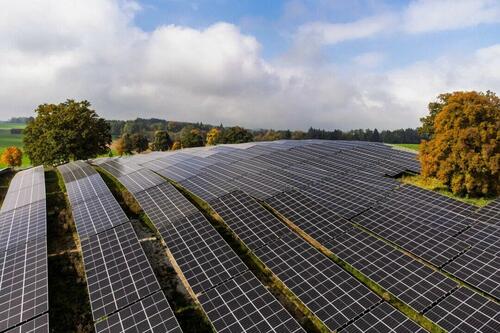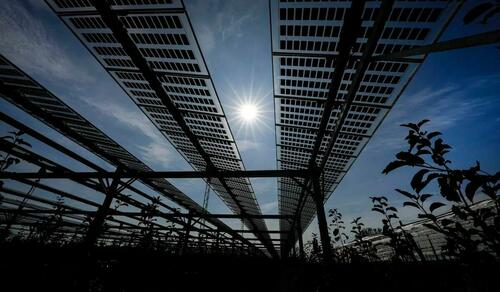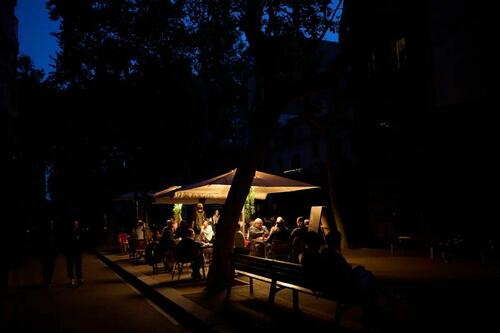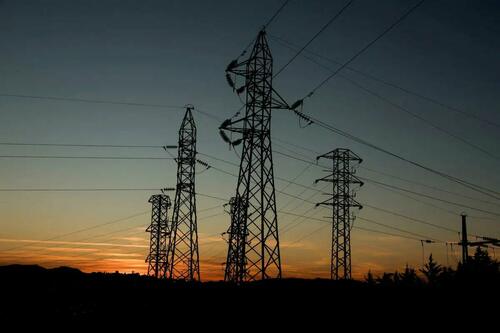Europe's Solar Surge Exposes Cracks In Aging Power Grid: Analysts
Authored by Evgenia Filimianova via The Epoch Times (emphasis ours),
Europe’s solar power boom is putting huge pressure on electricity grids that were never built to handle this much renewable energy, say analysts.
 An aerial view taken with a drone shows a solar energy field near Weilheim, Germany, on Oct. 16, 2025. Philipp Guelland/Getty Images
An aerial view taken with a drone shows a solar energy field near Weilheim, Germany, on Oct. 16, 2025. Philipp Guelland/Getty ImagesAs a record number of new solar panels are being installed every year, the old grid system is struggling to keep up.
Solar generation capacity in the European Union continues to increase and reached an estimated 338 GW by 2024, according to SolarPower Europe.
To curb its dependence on Russian energy and accelerate its green transition, the EU set a goal in 2022 to install at least 700 gigawatts of solar power by 2030, enough to supply electricity to hundreds of millions of homes.
But the rapid expansion has exposed cracks in Europe’s energy system, threatening to slow the transition unless grids catch up.
Europe’s power grids faced a surge in voltage problems last year, with 8,645 over-voltage incidents reported in 2024—nearly 10 times more than in 2023, according to the European Network of Transmission System Operators for Electricity (ENTSO-E).
 Special mounted solar panels are installed over a biological apple fruit tree plantation in Gelsdorf, western Germany, on Aug. 30, 2022. Martin Meissner/AP Photo
Special mounted solar panels are installed over a biological apple fruit tree plantation in Gelsdorf, western Germany, on Aug. 30, 2022. Martin Meissner/AP PhotoAging distribution infrastructure complicates the issue. Industry group Eurelectric estimates that nearly half of Europe’s distribution networks will be more than 40 years old by 2030.
Energy analyst and project lead at the Helmholtz Center Berlin, Susanne Nies, told The Epoch Times that Europe’s power system is under heavy strain because it was designed for a time when electricity made up only a small share of total energy use.
“When you go to the countryside and countries like France or even Germany, those grids have been built in the 50s. They are really nearly 70 years old,” she said.
Europe’s electricity system was initially designed for one-way flows—from large power plants to homes and businesses, Nies explained, adding that now it must handle power flowing in both directions, as millions of solar panels feed energy back into the grid.
She said today’s grid needs to combine large regional “super grids” with smaller, local systems that can operate independently during emergencies.
Harry Wilkinson, head of policy at the Global Warming Policy Foundation, said the challenge is not only that Europe’s grid is aging but that it must be vastly expanded to connect power sources that are far more scattered than in the past.
“Just the physical amount of additional cabling that you have to add to the grid, to connect, that is a big challenge, just in itself,” he said.
Voltage Problems and Spain’s Grid StrugglesMost voltage problems in 2024 originated from Sweden’s Svenska kraftnät, which implemented automated reporting, while operators in Slovenia, Moldova, and Romania also experienced increases as renewables expanded, according to Eurelectric.
Others fared better: Hungary’s MAVIR cut incidents for a second year, and grid operators in Spain, the Netherlands, and France reported none at all.
However, in April, huge power outages hit Spain and Portugal, leaving millions of homes and businesses without power. In Spain, where solar energy now provides about 21 percent of the country’s power—up from 8 percent five years ago—emergency measures have been necessary to prevent blackouts.
 Customers dine in a restaurant illuminated by a generator during a blackout in Barcelona, Spain, on April 28, 2025. AP Photo/Emilio Morenatti
Customers dine in a restaurant illuminated by a generator during a blackout in Barcelona, Spain, on April 28, 2025. AP Photo/Emilio MorenattiNies said that while in Spain’s case, the solar power grid was not the culprit, it has not been updated as fast as needed, and parts of it could be improved.
Wilkinson disagrees that it wasn’t the grid’s fault. He told The Epoch Times that renewables are simply more complicated to manage as a technology.
Nies noted that Spain remains poorly connected to its neighbors, while Germany’s grid is far more integrated, with four transmission operators and nearly 900 distribution system operators that manage local electricity networks.
According to independent energy consultant Kathryn Porter, location plays a far greater role in weaker grids. While frequency stays consistent across a network, voltage is a local factor that must be stabilized by nearby equipment.
“Spain’s conventional generation is concentrated in the north and east, while the south is dominated by renewables, making the southern network weak and increasingly difficult to control,” she said in her blog.
Grid SpendingSolar power supplies 22.1 percent of the EU’s electricity, according to energy thinktank Ember Climate, compared with 12.4 percent in China.
In the United States, the share is projected to reach about 7 percent in 2025, according to the U.S. Energy Information Administration.
Even as solar output soars, Europe’s electricity demand has stagnated, falling last year and recovering only slightly in 2025. Weak demand makes it more challenging to balance an energy system that is increasingly dominated by intermittent renewables.
The International Energy Agency (IEA) says investment in transmission and distribution networks is becoming critical as grid upgrades struggle to keep pace with the rapid buildout of low-emission power.
 Power lines connecting pylons of high-tension electricity are seen during sunset at an electricity substation on the outskirts of Ronda, during a blackout in the Spanish city, on April 28, 2025. Jon Nazca/Reuters
Power lines connecting pylons of high-tension electricity are seen during sunset at an electricity substation on the outskirts of Ronda, during a blackout in the Spanish city, on April 28, 2025. Jon Nazca/ReutersAnnual grid spending in the EU is set to exceed $70 billion in 2025, double the level a decade ago, the IEA said in a June report. Yet investment still trails the growth of clean-energy projects, leading to long connection queues and bottlenecks in moving cheap solar power from southern Europe to industrial centers in the north.
The European Investment Bank, the EU’s lending arm, warned in September that a lack of investment in grid spending causes inefficiencies in Europe and beyond. It stated that investment should remain a top policy priority if Europe wants to stay competitive.
When reviewing the overall economics of solar energy, the costs of grid management and the impact of high penetration levels on the grid are crucial, Wilkinson said. High penetration levels refer to a situation where the system relies heavily on one or more sources of renewable energy, which are intermittent and more challenging to ensure voltage and frequency stability.
“We should be realistic about the enormous cost burden that is likely to be faced because of those decisions,” he said.
New Solar InstallationsIndustry group SolarPower Europe expects a slight drop in new solar installations in 2025, marking the first decline in a decade. In its July statement, the group attributed the slowdown to grid bottlenecks, falling subsidies, and permitting delays.
The downturn is driven mainly by a slump in rooftop solar, especially among homeowners.
“In traditionally strong residential rooftop solar markets, like Italy, the Netherlands, Austria, Belgium, Czechia, and Hungary, households are now postponing installations as the impact of the 2022 energy crisis wanes,” SolarPower Europe said.
 Solar panels on a solar field in Moers, Germany, on Aug. 5, 2024. Ina Fassbender/AFP via Getty Images
Solar panels on a solar field in Moers, Germany, on Aug. 5, 2024. Ina Fassbender/AFP via Getty ImagesIt added that the withdrawal of incentive schemes without adequate replacements has led to a collapse of more than 60 percent in some rooftop markets compared with 2023, while Poland, Spain, and Germany have seen drops of over 40 percent.
A policy brief from Ember last year warned that renewable expansion was being “held back by urgent stress signals” in Europe’s electricity networks.
Another report by Strategic Energy Europe found that more than 1,700 GW of potential renewable capacity was being held in connection queues due to limited grid capacity.
Loading recommendations...